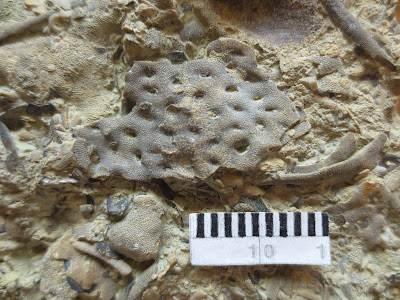 |
| As pictured here. If you enlarge it, you'll be able to more clearly see the tiny pores that were the living spaces of the bryozoan animals. |
Ulrich named this form in 1886 as Stictoporella? cribrosa, and it stayed in that genus until placed in the new genus Stictoporellina in Nekhoroshev (1956). Species of Stictoporella proper are also known from the Decorah and are thought to be related (Karklins 1970), but although they also make broad sheets, the sheets are not perforated, which makes them more typically bifoliate. Like Phragmolites, the type material of S. cribrosa is reported as part of both the former University of Minnesota collections (UMPC R5944) and the Smithsonian collections (syntype series USNM 43471, which Karklins [1970] split up and designated one specimen, newly numbered USNM 162015, as the lectotype). Both claimants are from the Decorah of Minneapolis.
 |
| Behold, a lousy photo of UMPC R5944. At least you can see the perforations in the piece on the slab and in the loose pieces. |
 |
| A clip from Ulrich (1895), Plate X, showing some views of his material of S. cribrosa (items 21–25). I suppose the object on the slab above might be item 21, but it's hard to tell from the photo. |
Because it made broad thin perforated colonies, Stictoporellina cribrosa is not the kind of thing that survives in one piece very well, or erodes out without breaking up, so you'll generally find it as fragments in slabs. Ulrich (1895) suggested S. cribrosa was restricted to the middle third of the Decorah, but Karklins (1970) reported that it was found throughout. In my own experience, I've found this species occasionally in the lower third, but it's certainly not particularly common. (This is more widespread than the non-perforate bifoliates, which I only ever seem to find in one location right above the Carimona.)
 |
| About what you can expect for loose pieces. |
Karklins (1970) made the interesting observation that he had not found S. cribrosa anywhere but in the Decorah of the Twin Cities. If this is true, this says something about the conditions of the Twin Cities Basin during Decorah deposition, that a bryozoan of this form could thrive there but not elsewhere. Most bryozoans you may encounter in this area are of twiggy to flat-branching shape (ramose or dendrose), with some bifoliate, encrusting, and massive forms for variety, and increasing numbers of hemispherical Prasopora going up.
 |
| As with some of the other photos, the thinness of the colony can be seen at the edges of the fragment. |
The saltine-like fenestrate S. cribrosa, interpreted as forming erect colonies, would have had completely different hydrodynamic properties than the ramose and dendrose bryozoans. (Nothing to do with S. cribrosa, but some of those branching colonies were incredibly delicate, judging by their fossils. Either the colonies were more flexible in life, or the Decorah seafloor was like a miniature glass forest.)
References
Karklins, O. L. 1970. Restudy of type specimens of the Ordovician bryozoan genus Stictoporellina. Journal of Paleontology 44(1):133–139.
Nekhoroshev, V. P. 1956. Klass Bryozoa. Pages 42–49 in L. D. Kiparisova, B. P. Markovsky, and G. P. Radchenko, editors. Materialy po paleontologii; novye semeistva i rody. Vsesoyuz, Nauchno Issled. Geol. Inst., Materialy, n. ser., vyp. 12, Paleont.
Ulrich, E. O. 1886. Report on the Lower Silurian Bryozoa with preliminary descriptions of some of the new species. Minnesota Geological and Natural History Survey Annual Report 14, for the Year 1885:57–103.
Ulrich, E. O. 1895. On Lower Silurian Bryozoa of Minnesota. Pages 96–332 in L.Lesquereux, C. Schuchert, A. Woodward, E. Ulrich, B. Thomas, and N. H. Winchell. The geology of Minnesota. Minnesota Geological and Natural History Survey, Final Report 3(1). Johnson, Smith & Harrison, state printers, Minneapolis, Minnesota.
No comments:
Post a Comment